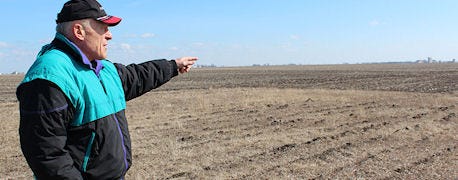April 21, 2014

In the summer of 1987, John Wilken installed new system tile in several fields in Iroquois County.
Due to budget limitations, 20 acres did not get completed; no drainage at all. The following year (1988) was a severe drought year that took a toll on all crops, but during harvest John noticed something interesting. Those 20 acres without tile had a much higher yield. Why?

Iroquois County Farmer Experiments With Water Control Structures
The tile system had done its job: it drained spring rains and removed excess water. But had those tiles gone too far? Did they remove moisture the crops would need later to survive the drought? "It made perfect sense to me," says Wilken. "Those acres that weren't totally drained held on to moisture that came in handy when my crops needed it most."
Since then, researchers at the University of Illinois and elsewhere began experimenting with a similar idea. They devised a new concept to allow customized flexibility with tile drainage systems. When Wilken learned about this in 2001, he contacted the Natural Resources Conservation Service and signed up to install "water control structures" on his existing tile system.
In 2002, Wilken and NRCS developed a plan for two fields—they set up 200-acres with five structures and three structures on another 160 acres. All structures were located in filter strips along the road, providing easy access to monitor and to make adjustments. Wilken received financial assistance to apply the practice through the Environmental Quality incentives Program, or EQIP, which reduced his out-of-pocket investment.
According to Kelly German, current District Conservationist in Iroquois County, Wilken was one of the early adopters for using Drainage Water Management, often called 'DWM.' "John's objective was to save moisture and hold back nitrogen to keep it out of his drainage water," German says.
Twelve years later, Wilken is still a believer. He has the management process with the structures down to a science. He applies anhydrous in the fall and shuts off drainage for the winter. The drains hold back water and the water table rises until he opens them early in March to prepare for planting. After planting, he closes them part way, allowing the water table to reach growing crops.
"It's easy to do and I can say that my crops benefit—especially when it's dry. Come July, I still have some subsoil moisture when other fields are bone dry," Wilken says. NRCS' Drainage Water Management practice can be part of a new tile system or added to existing tiles. "My 25-year old tiles and even my 50-year old tiles can handle the water and the pressure just fine," Wilken confirms.
With the complete support of his landlord, Wilken installed structures on her farm and also installed more on his own ground. His willingness to try this 'new' idea initially surprised some of his neighbors and caught the eye of other farmers and curious drainage contractors as well. According to Wilken, "It's a good long-term investment that needs minimal maintenance."
Nationally, NRCS maintains a detailed Conservation Practice Standard for DWM and recently embarked on an effort to promote the practice in ten Midwestern states.
"The potential for improving crop health in weather extremes is only one benefit," says Ivan Dozier, NRCS' State Conservationist. "Reducing nitrogen levels in water bodies in Illinois, in the Mississippi River basin, and beyond can really make a difference and improve water quality."
Wilken has farmed in East Central Illinois for 47 years. He has a history of making wise land use choices on his farm and served on the County Soil and Water Conservation District board from 2008 to 2012. He uses no-till and strip-till on most of his ground, has riparian buffer strips and field borders, a nutrient management plan, and recently entered into the Conservation Stewardship Program utilizing corn stalk testing for Nitrogen levels. John is watching the hot new trends for cover crops, but has yet to decide how to tailor it to his operation.
To learn more about this conservation practice, watch NRCS' short video that uses animation to show how DWM works underground: https://www.youtube.com/watch?v=j4mYch4RFsY.
Source: USDA NRCS
You May Also Like




